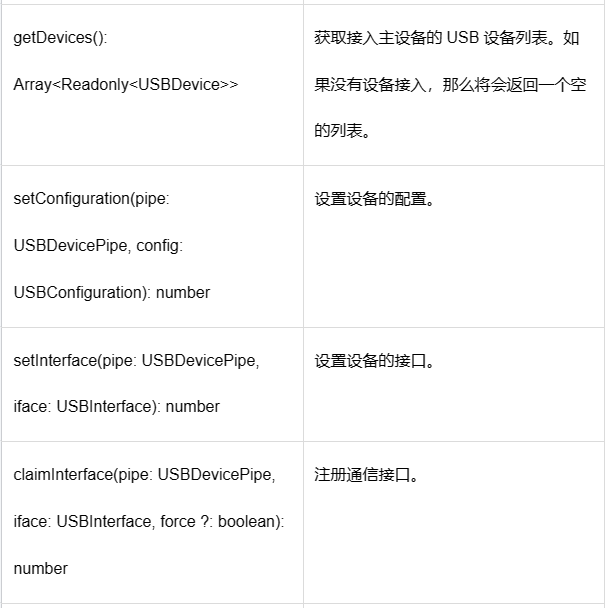基本概念
USB 服务是应用访问底层的一种设备抽象概念。开发者根据提供的 USB API,可以获取设备列表、控制设备访问权限、以及与连接的设备进行数据传输、控制命令传输等。
运作机制
USB 服务系统包含 USB API、USB Service、USB HAL。
图 1 USB 服务运作机制

● USB API:提供 USB 的基础 API,主要包含查询 USB 设备列表、批量数据传输、控制命令传输、权限控制等。
● USB Service:主要实现 HAL 层数据的接收、解析、分发以及对设备的管理等。
● USB HAL 层:提供给用户态可直接调用的驱动能力接口。
场景介绍
Host 模式下,可以获取到已经连接的 USB 设备列表,并根据需要打开和关闭设备、控制设备权限、进行数据传输等。
接口说明
USB 服务主要提供的功能有:查询 USB 设备列表、批量数据传输、控制命令传输、权限控制等。
USB 类开放能力如下,具体请查阅API参考文档。
表 1 USB 类的开放能力接口




开发步骤
USB 设备可作为 Host 设备连接 Device 设备进行数据传输。开发示例如下:
1. 获取设备列表。
```ts// 导入USB接口api包。import usb from '@ohos.usbManager';// 获取设备列表。let deviceList : Array<usb.USBDevice> = usb.getDevices();/deviceList结构示例[{name: "1-1",serial: "",manufacturerName: "",productName: "",version: "",vendorId: 7531,productId: 2,clazz: 9,subClass: 0,protocol: 1,devAddress: 1,busNum: 1,configs: [{id: 1,attributes: 224,isRemoteWakeup: true,isSelfPowered: true,maxPower: 0,name: "1-1",interfaces: [{id: 0,protocol: 0,clazz: 9,subClass: 0,alternateSetting: 0,name: "1-1",endpoints: [{address: 129,attributes: 3,interval: 12,maxPacketSize: 4,direction: 128,number: 1,type: 3,interfaceId: 0,}]}]}]}]/
2. 获取设备操作权限。
```tsimport usb from '@ohos.usbManager';import { BusinessError } from '@ohos.base';let deviceName : string = deviceList[0].name;// 申请操作指定的device的操作权限。usb.requestRight(deviceName).then((hasRight : boolean) => {console.info("usb device request right result: " + hasRight);}).catch((error : BusinessError)=> {console.info("usb device request right failed : " + error);});```
3. 打开 Device 设备。
```ts// 打开设备,获取数据传输通道。let interface1 = deviceList[0].configs[0].interfaces[0];let interface1 : number = deviceList[0].configs[0].interfaces[0];/打开对应接口,在设备信息(deviceList)中选取对应的interface。interface1为设备配置中的一个接口。/usb.claimInterface(pipe, interface1, true);
let pipe : USBDevicePipe = usb.connectDevice(deviceList[0]);
4. 数据传输。
import usb from '@ohos.usbManager';
import { BusinessError } from '@ohos.base';
/*读取数据,在device信息中选取对应数据接收的endpoint来做数据传输
(endpoint.direction == 0x80);dataUint8Array是要读取的数据,类型为Uint8Array。
*/
let inEndpoint : USBEndpoint = interface1.endpoints[2];
let outEndpoint : USBEndpoint = interface1.endpoints[1];
let dataUint8Array : Array<number> = new Uint8Array(1024);
usb.bulkTransfer(pipe, inEndpoint, dataUint8Array, 15000).then((dataLength : number) => {
if (dataLength >= 0) {console.info("usb readData result Length : " + dataLength);
} else {console.info("usb readData failed : " + dataLength);
}
}).catch((error : BusinessError) => {
console.info("usb readData error : " + JSON.stringify(error));
});
// 发送数据,在device信息中选取对应数据发送的endpoint来做数据传输。(endpoint.direction == 0)
usb.bulkTransfer(pipe, outEndpoint, dataUint8Array, 15000).then((dataLength : number) => {if (dataLength >= 0) {console.info("usb writeData result write length : " + dataLength);} else {console.info("writeData failed");}
}).catch((error : BusinessError) => {console.info("usb writeData error : " + JSON.stringify(error));
});
let inEndpoint : USBEndpoint = interface1.endpoints[2];
5. 释放接口,关闭设备。
```tsusb.releaseInterface(pipe, interface1);usb.closePipe(pipe);```
)













 向上偏移)
)


)
